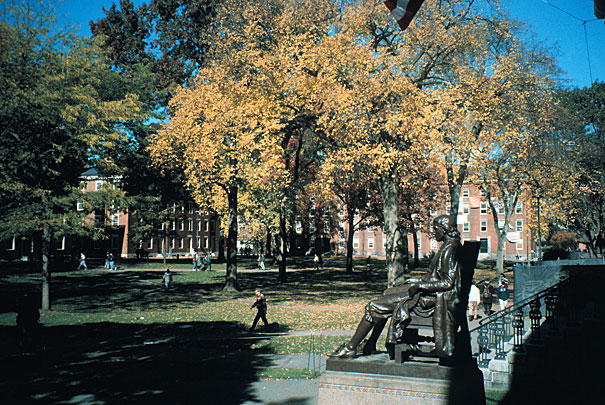
“Harvard’s revolutionary financial aid program continued to have a significant effect on the applicant pool,” said William R. Fitzsimmons, dean of admissions and financial aid, noting that there was an increase in both economic and ethnic diversity.
File photo/Harvard Staff Photographer
Early Action applications rise to 4,856
Students who applied by Nov. 1 will be notified on Dec. 13
A total of 4,856 students have applied for admission to Harvard’s Class of 2017 under the Early Action program, an increase of 14.9 percent over last year. The Class of 2016 had 4,228 students in the early pool.
Harvard restored Early Action last year after a four-year absence. A total of 772 students were admitted under the program, with the balance of the 2,076 students admitted through Regular Action.
Under Early Action, students apply by Nov. 1 and are notified by Dec. 13. Students admitted under Early Action are not obligated to attend and have until May 1 to reply.
This fall, students affected by Hurricane Sandy were given extensions to the deadlines for their applications, recommendations, and testing requirements. This long-standing practice of flexibility for students facing hardships of all kinds enabled some students to overcome a variety of challenges related to the storm.
“Harvard’s revolutionary financial aid program continued to have a significant effect on the applicant pool,” said William R. Fitzsimmons, dean of admissions and financial aid. Both economic and ethnic diversity increased. There was a 39 percent increase in those requesting a fee waiver, a 22 percent increase in applications from African-American students, and a 24 percent increase in applications from Native Americans, while applications from other minority students increased by smaller increments.
“Anyone considering Harvard, Early or Regular [Jan. 1 application deadline for March 28 notification], has access to Harvard’s new Net Price Calculator [NPC], a simple one-page application available on both the admissions and financial aid websites that provides an estimate of a family’s eligibility for assistance under Harvard’s generous need-based financial aid program,” said Sarah C. Donahue, director of financial aid.
Families with annual incomes of $65,000 or less are not required to contribute to their children’s educational expenses. Those with incomes from $65,000 to $150,000 pay on a sliding scale up to 10 percent of annual income, and there is also need-based aid available to families with incomes greater than $150,000. Families with significant wealth in all income categories are asked to contribute more. Home equity and retirement funds are not considered in the calculations, and students are no longer required to take out loans. More than 60 percent of Harvard students receive need-based financial aid and receive grants averaging more than $40,000.
“Our new School of Engineering and Applied Sciences continues to stimulate interest in Harvard,” said Marlyn E. McGrath, director of admissions. There was a 55 percent increase in the number of students interested in computer science, a 32 percent increase for math, a 29 percent increase for physical sciences, and a 24 percent increase in engineering.
“Other factors may also have played a role in having more students consider Harvard,” said Fitzsimmons. “The new Innovation Lab, the Harvard Initiative for Learning and Teaching, and edX, launched this past spring with MIT, have been noted by students we have met recruiting on the road this fall.”




